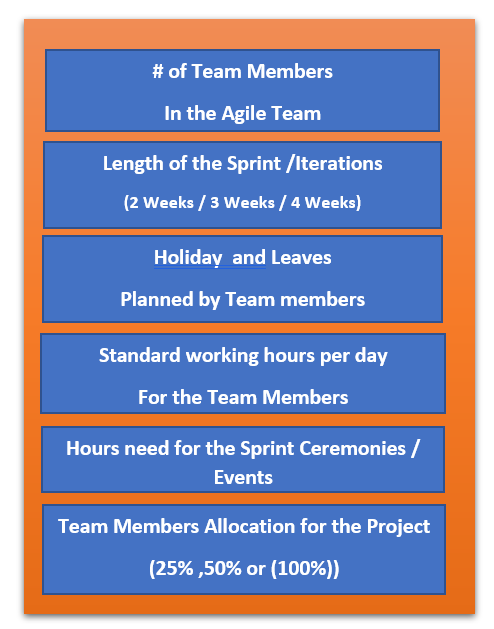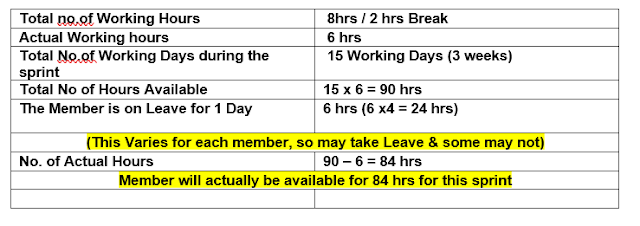CAPACITY PLANNING IN AGILE SCRUM
1.
What is Capacity Planning?
2.
Benefits of Capacity Planning
3.
How to do the Capacity Planning
4.
Examples of Capacity Planning
5.
Excel Template Sample
What is Capacity Planning?
CAPACITY PLANNING is the Available bandwidth or Productive hours of the Team
members to deliver the product.
PRODUCTIVE HOURS: The number of hours that the team members could spend to do the Actual
work in the project
Actual Hours: The Actual hours will be calculated after deducting the hours planned
for the sprint events / ceremonies
For Example:
If the team members work 8 hours per day
around 6 hours will be considered as Productive
hours
Remaining 2 hours will be used for sprint
events , internal discussions
Availability will be measured in Hours
CAPACITY PLANNING will be done for the
Team members for the Entire Sprint
BENEFITS OF CAPACITY PLANNING – Why
should we do the capacity planning
1. Understand the Available Bandwidth for the team to commit and complete the User stories.
2.Help the Team members to do the Better Planning Capacity planning will help the team members to do the better planning and task allocation of sprint goal . 3. Better visibility of the Team members Availability Capacity Planning gives the better visibility about Team members Availability to the Product owner(PO) 4. Avoid Task Overload and Frustration : Capacity Planning will help to Avoid Task Overload / Frustration 5. Plan the Sprint Goal Effectively : Capacity Planning will help to plan the sprint goal effectively and provide the Realistic commitment for the sprint . |
|||
How to do the Capacity Planning ? There are 6 key points to do the Capacity Planning Techniques of Capacity Planning Example:
Basic Equation: 1.
No.of Team Members x No.of Days in the Sprint x No.of Productive Hours 2.
Sprint Duaration = 3 Weeks for the Team = Week1 | Week 2 | Week3
= 15 Working Days => for the
# 3 Week Sprint
(By Excluding Saturday
and Sunday’s )
(Working
Days are considered from Monday
to Friday Only) 3.
Standard Working duration = 8 Hours / Day 4.
Total No.of Vocation days planned by the team = 4 Days 5.
No.of Working Hours considered for the
Vacation days = Zero Hours
( 0 – Hours ) 6.
First “Thursday” is Holiday
for All the Team Members (Work Hours for that day is Zero) Explanation: 1.
Out of 8 hours per day è 6 hrs are considered as Actual
Work => 2 hrs are planned for Meetings , Discussions etc 2.
So we can see : 6 hrs per day for
Each team members 3.
On the First day of the sprint , Team will spend 4hrs -à 1 week for “Sprint Planning Meeting” So the Capacity is considered as 4hr for each Person
à on the First Day of the sprint 4.
Capacity of Each team member work is shown in the last column at the right side From the Example : For Joe , its 82 hrs For Kumar, its 70 hrs etc This is the individual Team member
capacity for this 3 week sprint .
Total Capacity of the Team members is
calculated – by Adding all the Team members capacity As per Example Total Capacity of the Team = 552 hours
So |
|||





Comments
Post a Comment